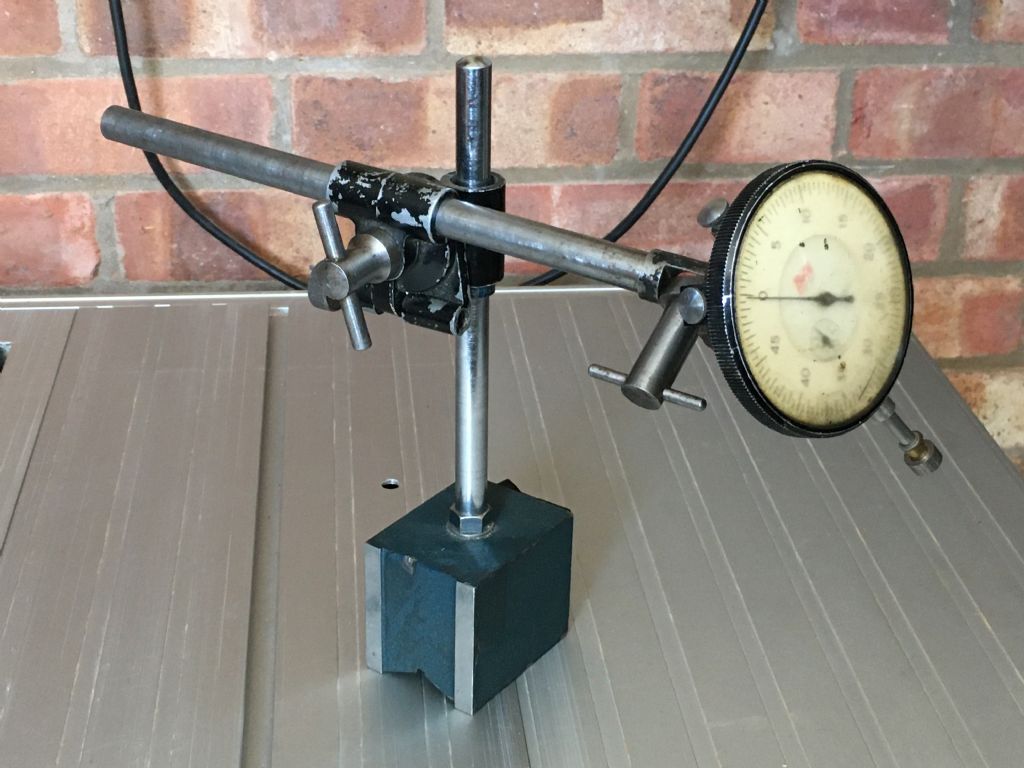Posted by Mike Donnerstag on 30/05/2020 13:21:45:
Hopper: I don’t know much about the use the machine had been put to prior to my owning it, but I think your suggestion of a previous owner threading using a die-holder would account for that bed wear.
Measuring again, apart from the last 2 inches of the bed, the bed width across both shears shows no more than 1thou of wear (not bad at all!), according to my digital calipers (the only micrometer I have is 0-1&rdquo . This includes the visibly worn area on the top of the front shear. The final 2” measures 1.5-2thou above that, which accounts for my initial wear measurement of 3.5thou.
. This includes the visibly worn area on the top of the front shear. The final 2” measures 1.5-2thou above that, which accounts for my initial wear measurement of 3.5thou.
Slightly off-topic, but where did you get your small red magnetic indicator stand?
Or, is it an expensive Noga? My magnetic stand is quite large and the dial gauge on top is even larger. For that reason I tend to use a sensitive dial test indicator in the toolpost whenever possible, but I do need to buy a more compact magnetic stand to make setting up easier. My Batty in the magnetic stand is pictured below. I don't use it much as it's just too bulky and a pain to set up.

Edited By Neil Wyatt on 30/05/2020 22:02:03
Hi Mike
The stand and the DTI are eBay cheapies. Seem to work just fine.
Re your bed measurements above it sounds like that scarred up area is the cause? It would pay to measure the width of the back shear itself and try to determine how much wear is on that very rear guiding surface without interference from that scarred up front shear.
Sounds like in the meantime you have the spindle movement in the ballpark. A little more than I would aim for but I think acceptable and almost certainly not enough to cause barrel shaped turning. No idea what the factory clearance spec is for the Super 7 oddball bearing set up. I aim for half a thou on plain bearings like the ML7 but I think your one thou or so should be passable.
Did you run a flat file over that scarred up front shear to make sure there is no raised ridge of metal around its edges? Might be worth a try.
Another thing you could try is setting up the lathe in the absence of expensive level by using the second method in the Myford owners manual that I described in a post above earlier, basically with a dial gauge on a long bar in the chuck to make sure no stress is put on the bed during bolting down.
Yet another thing I would look at is how you are holding your test piece for turning. Your OP said you only had 1" held in the collet. I would like to see double that if I were doing it. In fact I would fit the four jaw chuck and hold the bar in that. Just to eliminate the possibility of some movement of the job in the collet under load in a job sticking out so far. Don't use your three jaw chuck for this test as it is quite possibly bell mouthed if in similar condition to that bed!
blowlamp.


 . This includes the visibly worn area on the top of the front shear. The final 2” measures 1.5-2thou above that, which accounts for my initial wear measurement of 3.5thou.
. This includes the visibly worn area on the top of the front shear. The final 2” measures 1.5-2thou above that, which accounts for my initial wear measurement of 3.5thou.


